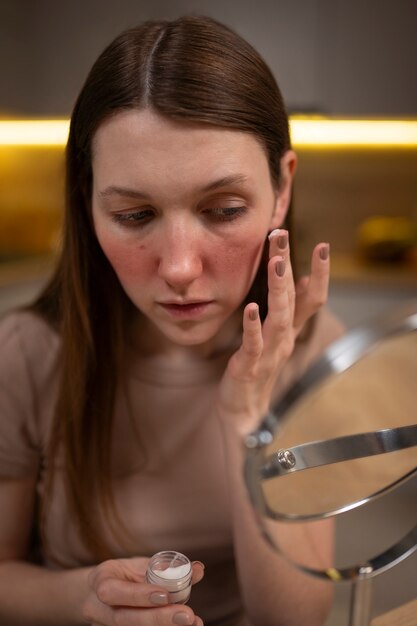
No matter your skin type, skin issues can arise at any time in your life. One common problem is the appearance of red spots, which can develop as rashes, blemishes, or bumps. Luckily, in many cases, you can address this issue at home with simple remedies and achieve lasting results.
Red spots, also called rashes, often appear due to skin irritation, infections, or allergic reactions and can spread to different parts of the body. Medically, redness of the skin is referred to as erythema. If the spot is flat, it’s called a macule; if raised, it’s termed a papule. A single red spot could also be a benign growth like a hemangioma, while purplish ones caused by bleeding under the skin are known as purpura. Tiny pinpoint spots may be referred to as petechiae.
While these spots might seem like a blemish on your appearance, especially on the face, they’re mostly harmless and often fade on their own. However, it’s essential not to ignore them if they persist or worsen. Understanding the causes of red spots can help you take timely action to treat and prevent them.
In some cases, red spots accompanied by itching or hives might indicate underlying medical issues and should not be ignored. Immediate medical attention is necessary if the condition worsens or if other symptoms develop.
### Symptoms of Red Spots on the Skin
The signs and severity of red spots can vary depending on the cause. These spots may appear temporarily or, in rare cases, remain long-term. Common symptoms include:
– Pain
– Swelling
– Irritation
– Itchiness
– Raised or flat texture
– Uneven surface
– Red, purple, or dark discoloration
– Scaliness
– Skin dryness or sensitivity
– Hair loss in the affected area
### Common Causes of Red Spots
The appearance of red spots can stem from various reasons, ranging from mild to severe. They may be itchy, painful, swollen, or fluid-filled, or sometimes they appear without other noticeable symptoms. Here are some common causes:
– Acne or pimples
– Allergies or chemical reactions
– Insect bites
– Hives
– Birthmarks
– Viral, bacterial, or fungal infections
– Medications
– Heat rash
– Excess protein production
– Bleeding disorders, such as petechiae or purpura
– Skin conditions like rosacea, eczema, or toxic epidermal necrolysis
### Home Remedies for Red Spots
Several natural remedies can help reduce or eliminate red spots on the skin. Below are some simple treatments you can try at home:
#### Apple Cider Vinegar
With mild acidity and antibacterial properties, apple cider vinegar can restore the skin’s pH balance and soothe irritation.
– **Ingredients**: ½ tsp apple cider vinegar, 2 tbsp water, cotton ball
– Mix the vinegar with water and apply to the affected area using a cotton ball. Let it dry, then rinse and moisturize. Repeat twice daily.
– *Important*: Always dilute apple cider vinegar to avoid skin irritation.
#### Coconut Oil
Coconut oil’s anti-inflammatory properties make it an effective remedy for redness caused by inflammation or skin irritation.
– **Ingredients**: 1 tbsp virgin coconut oil
– After cleaning your skin, gently massage coconut oil onto the affected area and leave it on overnight. Repeat every night until you see improvement.
– *Note*: Avoid this remedy if you have acne-prone skin, as it can clog pores.
#### Dandelion Root
Dandelion root supports skin healing, reduces inflammation, and protects against redness caused by eczema or acne.
– **Ingredients**: 1 tsp dandelion root powder, 1 cup hot water
– Brew the powder in hot water, strain, and drink the tea 1–2 times daily for a few days to reduce red spots.
#### Cocoa Butter
Cocoa butter not only moisturizes but also soothes inflamed skin and lightens red spots caused by irritation.
– **Ingredients**: Organic cocoa butter
– Massage a small amount of cocoa butter onto the affected area and leave it overnight. Rinse your skin in the morning. Apply nightly until results are visible.
– *Caution*: Perform a patch test first if you have oily skin, as cocoa butter’s high fat content can cause breakouts.
#### Aloe Vera
Known for its soothing, antibacterial, and antioxidant properties, aloe vera gel helps heal skin and reduce redness.
– **Ingredients**: Aloe vera leaf
– Extract the gel, apply it to red spots, and massage gently. Leave it on for 20–30 minutes before rinsing with water. Use twice daily for best results.
#### Lemon Juice
Lemon juice, rich in Vitamin C and antioxidants, can lighten red spots and improve overall skin tone.
– **Ingredients**: 1–2 tbsp fresh lemon juice, cotton ball
– Apply the juice to the affected area using a cotton ball and leave it on for 5 minutes before rinsing. Repeat twice a day.
– *Caution*: Dilute lemon juice if you have sensitive skin, and always follow up with sunscreen to prevent photosensitivity.
### Prevention Tips: Sun Protection and Hydration
Excessive sun exposure can worsen red spots, leading to further inflammation and irritation. Always apply sunscreen with SPF before stepping outdoors, and try to limit sun exposure. Staying hydrated is equally important, as dehydration can cause skin dryness and exacerbate redness.
### When to See a Doctor
If red spots persist, recur, or are accompanied by severe symptoms, such as fever, blistering, or infection, consult a doctor immediately. Some red spots could indicate serious health conditions or require medical treatments like prescribed ointments, cosmetic procedures, or lifestyle adjustments.
Signs that you should seek medical attention include:
– Persistent spots that don’t fade over time
– Accompanying symptoms like fever or blisters
– Rapid spreading or significant pain
– Signs of infection, such as pus or warmth in the area
While many red spots can be treated with simple home remedies, don’t hesitate to seek professional care if the symptoms worsen or don’t improve.